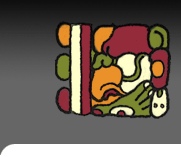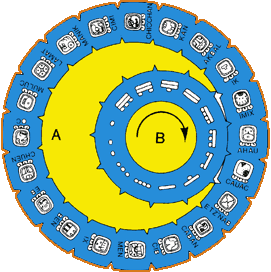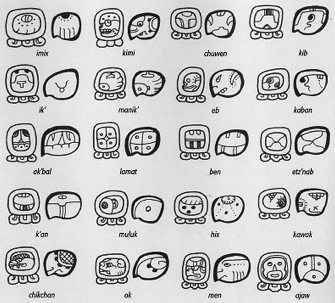 |
 |
 |

The 260-day Tzolk'in, or sacred calendar, is the oldest calendar cycle known in Mesoamerica, dating back to at least 600 BC. While some scholars are still searching for an astronomical basis for this cycle, most agree it was based on the nine month human gestation period. As a testimony to the tzolk'in's centrality to Maya culture, it is still observed today among traditional Maya groups.

The mechanics of the tzolk'in The mechanics of the tzolk'in involve 13 numbers paired with 20 day names. Because 20 is not evenly divisible by 13, the two sequences are out of phase with each other (Figure 1.) A day such as 3 Manik' will not recur until all the numbers and names have run through a complete 260-day cycle. Thus, there is a unique day name for each of the 260 days, no weeks or months. For those who seek meaning in the days of the Maya calendar, the tzolk'in is where they will find it. For the modern Maya of Highlands Guatemala, who call the sacred calendar the Cholq'ij, each of the 20 day names has its own spirit. Its number coefficient speaks to its weakness or strength on that given day. The day on which you were born defines your soul, character and destiny. In this regard, the tzolk'in is the closest correlate to the western notion of astrological signs. To learn what your tzolk'in sign is and its meaning, read the Maya Birthday Divination Section. 
The twenty days of the Tzolk'in (Image adapted from Voss 2000) Regardless of which Mesoamerican culture one looks at, the 260-day calendar consists of 20 symbols, each one counted 13 times in the cycle. To the Maya, this calendar was called the Tzolk'in, to the Aztec's the Tonalpohualli, and to the Zapotecs the Piye. While each culture had its own versions of these symbols and expressed the day names in their own languages, there exists an almost one to one correlation in their root identities. Considering that Mesoamerican cultures are geographically and chronologically divergent, the fact that their 20 day symbols are so similar points to a very ancient origin, probably in early Olmec times. The 260-day is very much still in use among the Maya communities of the Highlands Guatemala and Chiapas. Most people in these communities are aware of their 260-day birthday and the priests named Aj Kin or "Day Keepers" are honored individuals. Counting through the 260-day calendar gives them the power of divination. Corn seeds and crystals grabbed from within the Day Keeper's bag are arranged in a grid formation on a table or flat surface. Starting with the day of the divination, they count through the seeds and crystals, stopping on a day when they get a feeling referred to as "lightening blood." Each day has its own qualities, and the meaning is interpreted based on the circumstances and questions asked. A single divination ceremony counts through the seeds multiple times, stopping on 3 or 4 days names along the way. In common practice, divinations are requested by community members who are looking for advice. The cause of illness, business questions, marriage plans, and planting advice are among the more common questions asked. There are said to be 260 shrines peppered throughout the highlands, one for each day of the calendar. Most are in Guatemala, but a few are said to be located in Honduras and Chiapas. Another handful are located in Guatemala's Peten rain forest. In all cases, they are in a natural place - a mountain top, a river valley, a cave, etc.. Day Keepers are required to pray at these shrines occasionally, sometimes on the day of that same name, other times in response to the results of a divination. For example, 8 B'aatz (8 Monkey) is an important day for priests to introduce their apprentices to the Earth Grandfather, called the Mam. Prayers take place in various places, but usually around a freshly built Maya altar. An altar consists of a set of six colored candles arranged to represent the four directions and the center. Red for the East, white for the South, yellow for the West, and black for the North. In the center are placed two candles, blue and green. The Maya word of these two colors is the same, yax. Flowers, incense, chocolate, and other items are arranged in a cross connecting all the candles. The altar is then lit on fire and tended as the Day Keeper prays in front of it, walks around it, and pours alcohol at it's four corners. Quietly chanting, the priest's prayers are directed to the 260-days, each named out loud and implored to hear the prayer. Each day is addressed with titles of respect and as a living spirit or force of nature. |


